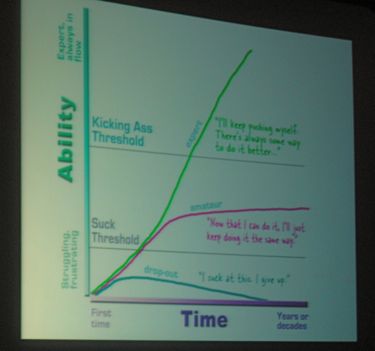In yet another example of how blogging is changing the news business and the PR business, it’s interesting to go back and look at what happened over the past 10 days or so with a story relating to Best Buy — a company I know well, headquartered right here in suburban Minneapolis. 
This little tale is instructive to those involved in communications and journalism.
First of all, I think the underlying news story here is a positive one for Best Buy, and for its employees and shareholders. (Full disclosure: I like the company, I have friends there, and I did a little interim gig there myself back in 1999/2000. It is an amazing outfit.) But it’s still interesting to watch big companies like this try to deal (or fail to deal) with the realities of new media.
Here’s the story as it broke locally here in the Twin Cities yesterday (Friday), by our very good Business Journal: Best Buy builds VC unit to find next big things. (More disclosure: I was contacted early in the week by one of the writers of this story to provide reaction to the news, and was quoted in it.) But what’s more interesting to me, even than the news itself, is the fact that it wasn’t first discovered by a traditional media outlet: a blogger had actually broken this story the week before. If you’re in the journalism or PR business and have any sense of the changes being wrought by new media, you of course know such occurrences are becoming more and more common.
The Fuse Is Lit
A consumer electronics blogger by the name of Lee Distad in Edmonton blogged this piece of news first on March 18 with this post: Best Buy Capital to Invest in Tech Innovations. He had more to say about it on a weekly recap he did the same day on another blog: Best Buy Opens Their Own Venture Fund. Soon, another blogger, who happens to be a VC (and also a Canuck) — that being Paul Kedrosky of the blog Infectious Greed — had picked up on Distad’s breaking news and posted a link in his own post: Return of Corporate Venture Investors. (A little aside: what he fails to realize, and the others as well, is that Best Buy is not a new corporate venture investor; they’ve been at this game for many years. The new entity appears to signal simply an expansion or formalization of their practice of making minority investments in promising new companies from time to time that are strategic to their business. The name Best Buy Capital just appears to perhaps be a new name for this entity — though it should not be confused with an old entity called "Best Buy Capital LP," which the company formed in 1994 to raise expansion capital, as this old SEC filing details.)
Then (within minutes, I suspect), the blog TechConfidential (from TheDeal.com) was running a post with an even better headline — With Best Buy Capital, corporate VC goes big box. (Disclosure: I have been invited to be a member of the TechConfidential blogger network, though I did not see their story on Best Buy till this week.) You can see in their post that they included, like good little bloggers, links to the earlier posters, dutifully paying them homage. TheDeal.com exists to serve investors, so you can be sure plenty of people who follow BBY stock got early wind of this story, actually well ahead of the general market. (Did it cause a blip in the share price? Maybe not all by itself, but I see the stock did trade up that day. Investors hunger for every little piece of news about the companies whose stocks they hold.)
Okay, so what’s so interesting about a bunch of bloggers who sniff out a story for their relatively small audiences, which is then broken as a piece of hard news later in Best Buy’s hometown by a large, traditional media weekly that reaches many tens of thousands more people? Nothing so much, since it’s happening a lot these days. What’s interesting to me is that, as Distad reports in his original post, not only could he not get any information or a comment from the company’s PR people — they didn’t even seem to _know_ anything about this particular development within their company! And, as you can see, our local Business Journal was also unable to get a comment from a Best Buy source for their story, a full 11 days after the original blog post.
The Disconnect
If you haven’t picked up yet from one of the links above, here’s how the original blogger discovered the story…are you ready? From a job posting. That’s right, a little known but valuable source of news that smart people looking for insights about a particular company can often find — right on the company’s own web site! (Or on any of a number of other job boards.) This isn’t news about what’s happening now, mind you. It’s better than that: it’s about what’s coming. Hiring plans definitely qualify as a bellweather of things to come.
So then, what does Best Buy do (ostensibly on a call from the PR people to the HR people) — they take the job posting down! There, that will fix those pesky, nosey outsiders! Now, those links in the above original blog posts go to a dead page. Not to worry, however — it took me less than a minute to find the job description had been copied and posted to another job listing site here. That’s the thing about the web: once something’s out there, it’s impossible to fully take it back. (This is the posting for a "Principal," whereas another job had been originally posted by Best Buy for the position of "Associate," which I did not search further for. A source of mine within Best Buy told me this week that three people would be hired for Best Buy Capital; I would guess that to be one Principal and two Associates.)
Now, it could be said that this was just a coincidence — that the job postings were removed because the company had suddenly filled all three positions. Hardly likely, since the original posting appears to have only gone up on March 11. (And I know how long things take at Best Buy.) It seems much more likely the company was spooked by a blogger breaking a story that, for some strange reason, they did not want known. Or did not go through "normal channels." (Hint to Best Buy: the world is changing, and, like it or not…channels aren’t normal anymore.)
But what I find the most interesting of all is that the HR people, through their job-posting system (they use the very common Taleo platform), are putting out news that they apparently don’t realize. That is, no one seems to have explained this to them. I’m surmising they don’t tell the PR people when they do post something like this — witness the original blogger running into complete ignorance of the news when he called PR. By the same token, the PR people aren’t trolling the postings regularly themselves, either, it would seem, to become aware of "news" the company may be putting out in ways other than the limited supply they dish out themselves. And limited it is. They, like most big companies of old (and so many overly regulated public firms, I suppose), seem to spend more time keeping the news in than letting it out.
Two things I would ask: (1) Shouldn’t Best Buy (and other companies of their size) start figuring out how to deal with the notion of transparency in our new world of New Media? And, (2) Doesn’t it seem to you that somebody should get the HR people and the PR talking?




 Gee, I guess you could say the market likes it? And this after a page-one Journal story today suggesting Jobs knew more than previously reported about his company’s options backdating. To hell with that, the market seems to be saying — just keep giving us those good results.
Gee, I guess you could say the market likes it? And this after a page-one Journal story today suggesting Jobs knew more than previously reported about his company’s options backdating. To hell with that, the market seems to be saying — just keep giving us those good results.
Recent Comments